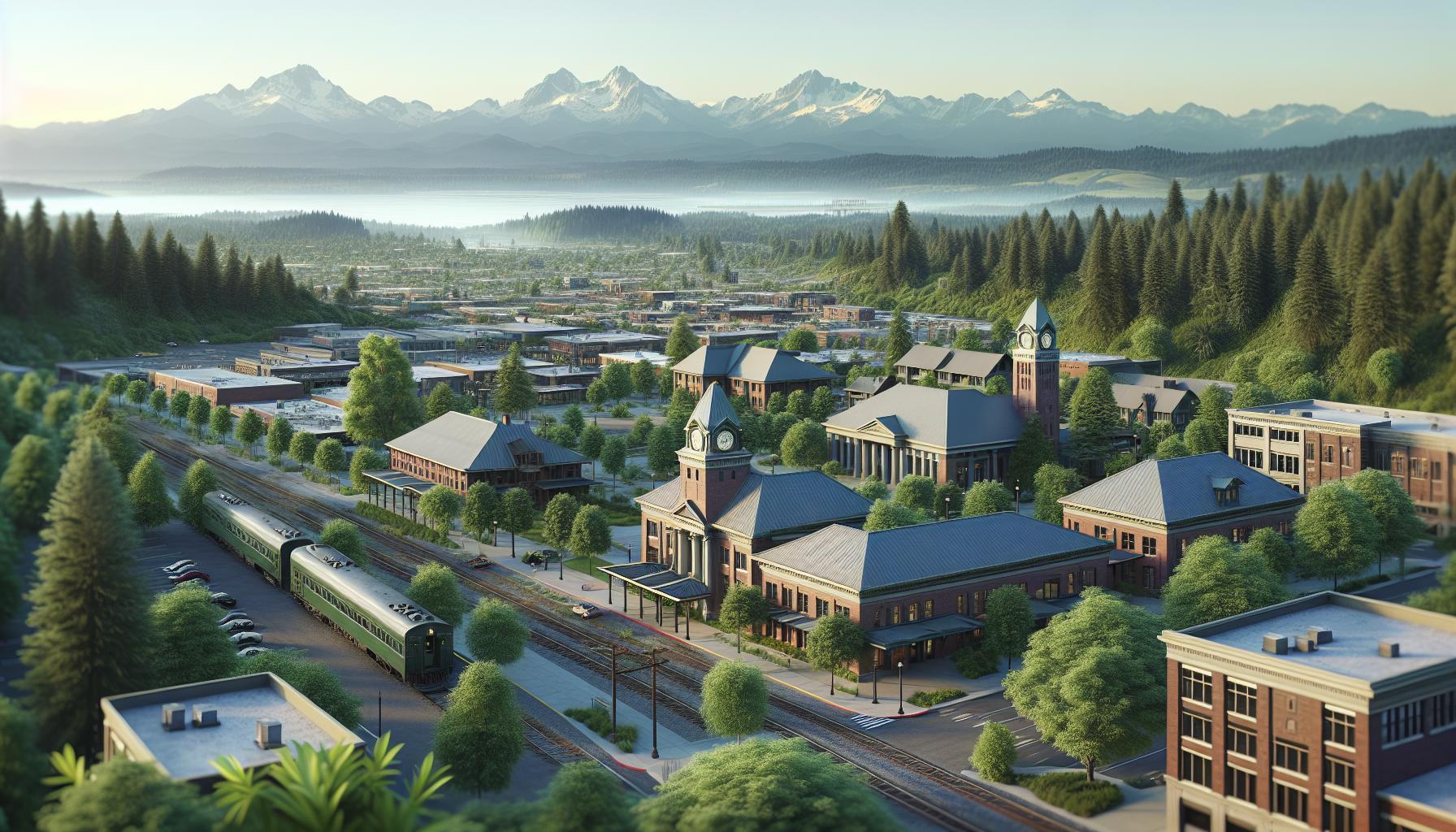Nestled in the heart of Washington State, Issaquah is more than just a picturesque town. It’s a treasure trove of stories, waiting to be unearthed. From its humble beginnings as a small mining community to its evolution into a bustling suburb, Issaquah’s rich history is a fascinating journey through time.
But, what makes Issaquah’s past so captivating? Is it the tales of pioneers braving the wilderness, or the transformation brought about by the railroad and coal mining? Maybe it’s the enduring spirit of its people, reflected in the town’s growth and resilience. Let’s dive in and uncover the hidden gems of Issaquah’s past.
Exploring Issaquah’s Early Beginnings
Before delving into the minutiae of Issaquah’s rich history, it’s critical to understand its foundational years. Let’s embark on the journey of Issaquah’s early beginnings, focusing on native influence and the town’s birth as a mining hub.
The Native Influence and Initial Settlers
Long before Issaquah became a bustling suburb, it was the land of the Snoqualmie people. This tribe, part of the Coast Salish Native American group, left a lasting impact on the region. Their affinity for nature and their skill in fisheries, for instance – Coho, Steelhead, and Sockeye Salmon – still resonate in Issaquah’s culture.
Fast forward to the mid-19th century, pioneers seeking new opportunities found their way to this fertile land. Among the initial settlers were notable figures like Luke McRedmond and Ingebright Wold. Their audacity laid the foundation for Issaquah’s future. They established farms, logging operations, and eventually engaged in local governance.
Issaquah’s Birth as a Mining Town
Post-settlement, Issaquah transformed into a booming coal mining town by the late 19th century. Nestled amidst the fertile landscape was a treasure – copious seams of coal. Mining businesses sprang up, drawing workers from far and wide, thus marking the birth of Issaquah as a mining town.
Remarkably, Issaquah produced approximately 500,000 tons of coal between 1862 and 1898. The impact of this period on Issaquah’s demographic and economic growth was substantial, paving the way for its evolution into a thriving community.
Understanding these beginnings can offer fantastic insights into the town’s transformation over the years. The exploration of Issaquah’s rich history continues as we delve deeper into successive eras and how they shaped the Issaquah we know today.
Economic Transformations Through the Decades
As the timeline of Issaquah’s prosperous history unfolds, the subsequent decades brought major economic changes. Cataloguing these transformations, let’s delve into the periods of significant economic shifts.
From Coal Mines to Railroad Hub
Once known as the coal mining epicenter in the late 1800s, Issaquah underwent a dramatic change in the early 20th century. Mining operations began to fade as new technologies emerged. Concurrently, transportation started to shape Issaquah’s economic landscape. By the 1910s, the community acknowledged the potential of railroads, following a national trend.
Issaquah’s proximity to Seattle became a strategic advantage. Rail lines connected the small mining town to the bustling city, altering Issaquah’s economy significantly. Railroads, primarily intended to transport coal and timber, gradually became a conduit for people. This evolution boosted local commerce and fostered Issaquah’s growth into a bedroom community for Seattle.
A fun fact: Issaquah trolley service, a remnant of this era, remains a popular tourist attraction even in the 21st century.
The Rise of Timber and Agriculture
With the dwindling coal industry, folks in Issaquah did not just wait around for the next big thing. They adapted. By the mid-20th century, timbering and agriculture emerged as prime economic activities. The lush evergreen forests encircling Issaquah became the source of a vibrant timber industry. Large quantities of Douglas-fir and Western Hemlock, for instance, were harvested for building and manufacturing needs.
Meanwhile, fertile lands nourished by the Issaquah Creek made Agriculture a successful venture. Issaquah’s fields blossomed with crops such as hops, and barns started brimming with dairy products. Local farms witnessed prosperity and further diversified Issaquah’s economic landscape.
Cultural Milestones and Heritage Preservation
Preserving cultural heritage, it’s more than just clinging to the past. It offers a sense of continuity, providing a link between the past and future. With that said, let’s dive into Issaquah, Washington’s rich tapestry of cultural milestones and the efforts in preserving the city’s legacy.
Notable Historic Sites in Issaquah
Beginning our journey, I look at some of Issaquah’s most standout historical sites. The Gilman Town Hall, completed in 1888, is one such site. Once a focal point for several community gatherings, it’s still maintained to keep the town’s social life alive.
Another significant site is the Issaquah Train Depot. Built in 1889, it served as Issaquah’s main connection to Seattle and other towns. This historic building transformed the isolated coal mining town, bringing unprecedented economic opportunities. This train depot personifies Issaquah’s transition, and it’s a testament to the town’s resilience and adaptability.
Cowboy singer, rancher, and philanthropist, the historic Boehm’s Candies and the magnificent St. Joseph’s Church reflect the impact of Max H. Hobart’s life (1895-1974) on the city. These landmarks serve as enduring symbols of the rich cultural heritage of Issaquah.
Efforts in Preserving the City’s Legacy
Issaquah’s commitment to preserving its rich history is highlighted by the sheer number of preservation efforts taken. The Issaquah Historical Museums, for instance, embody this commitment. These museums, managed by the Issaquah History Society, hold a vast collection of artifacts and documents that trace the city’s lineage back to its origins.
The City of Issaquah itself too established the Development and Design Standards. It’s aimed at protecting historical and cultural resources, helping preserve the city’s character. Additionally, they’ve adopted a comprehensive Historic Preservation Plan charting a clear path for safeguarding Issaquah’s heritage.
Another testament to Issaquah’s preservation endeavours is the Olde Town Subarea Plan. It ensures the preservation and enhancement of Issaquah’s original downtown area’s unique character.
Through these efforts, Issaquah continually celebrates its vibrant past, even as it faces the future with equal zeal. Being able to explore the city’s heritage, we might realize – it’s these layers of history that make Issaquah what it is today, a bridge between eras.
Issaquah Today and Its Historical Influence
Peeking into today’s Issaquah, you’d find a bustling city steeped in history. Its roots run deep into the fabric of the past, shaping every aspect, be it tourism, economy, or community living.
Tourism Rooted in History
Today, Issaquah’s historical treasures draw crowds from around the globe. It’s the historic sites, like Issaquah Train Depot and Gilman Town Hall, that spark curiosity, showcasing times long passed. Visitors flock to Boehm’s Candies, an iconic locally-owned chocolate factory that’s been in operation since 1956, to get a taste of traditional Swiss chocolate-making techniques. Additionally, St. Joseph’s Church, an 1890s mission-style architectural gem, also crowns Issaquah’s must-visit list. Thus, it’s evident that historical preservation efforts have reassured a thriving tourism industry focused on Issaquah’s rich past.
How History Shapes Modern Issaquah
History doesn’t just lay groundwork for tourism; it profoundly shapes modern Issaquah. The city today is a testament to the pioneering spirit of those like Luke McRedmond and Ingebright Wold who set the tone for development and progress. The land, once a hub for coal mining and railroad connectivity, now houses some of the country’s top tech giants. But, amidst all the advancements, there’s an unwavering commitment towards perseverance of the past. The city’s Development and Design Standards and the Olde Town Subarea Plan lay emphasis on maintaining Issaquah’s aesthetic charm, with buildings mirroring the historic architecture. Thus, modern Issaquah stands as an embodiment of its history, visibly influencing its urban space and city planning.
Indeed, today’s Issaquah is an interesting blend of the past and present, showcasing a rich history while thriving as a modern suburban city.
Conclusion
So there you have it. Issaquah’s journey from a humble mining community to a vibrant suburb is nothing short of fascinating. It’s a testament to the city’s resilience and adaptability, all while honoring its roots. The efforts to preserve and showcase its rich history, from the historic sites to the museums and preservation initiatives, are truly commendable. It’s not just about looking back, but also about carrying that legacy forward into the present day. What’s more, Issaquah has managed to strike a balance, offering a blend of historical charm and modern living that’s quite unique. It’s a city that’s proud of its past, yet eager for its future. And that’s what makes Issaquah, with its rich history and vibrant present, a place worth exploring.





0 Comments